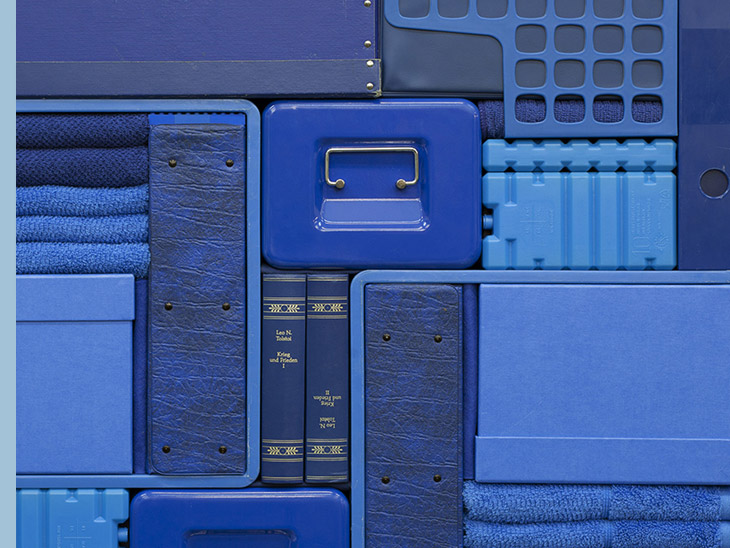SPATIAL PUZZLE-LIKE INSIGHTS
Swedish installation artist Michael Johansson (1975) re-contextualises the readymade, freeing mundane objects from their function to produce geometric sculptures and neatly constructed installations. His art pieces are recognisable yet unique, archaeologies of everyday life compressed into rectangles or cubes. Playfulness and a great sense of humour characterizes the art of Michael Johansson, obsessed with investigating and defining the limits and possibilities of space and objects. He plays with things by arranging them as a puzzle to fill a selected space of any kind or dimension. Just about any space is a spatial canvas for Johansson. Driven by the agenda to densify the world, objects are morphed into precisely stacked rectangular shapes, connected to a certain place, where their original purpose are transformed into catalysts of new meanings. Everyday life and fantasy become one in a thought-provoking site-specific situation. The least you can say is that artist Michael Johansson is a tidy man.
I'm a big fan of Beaufort. Beaufort is a triennial of contemporary art along the Belgian coast. Since 2003, six editions have already taken place. Works of art were erected in the public spaces spread over the 9 coastal municipalities. The artworks on display are specially designed for the project or already existing works that will be taken to the coast for the duration of the project. During the fourth edition, Beaufort04, — which was an exceptionally interesting edition — quite a few creations referred to the sea as a symbol of endless desire. Although many interpretations remain possible. I remember the empty containers in the shape of ships, Coast to Coast, by the Estonian artist Flo Kasearu. They could symbolize sea transport, but just as well the economic crisis or the illegal immigrants who want to go to England. Most terrifying I found the car wrecks standing on the beach with aggressive looking dogs around them by Italian Paolo Grassino. Another impressive work was Sandworm by Marco Casagrande from Finland. And, of course, The Move Overseas, a creation by Swedish artist Michael Johansson. It was a construction of stacked containers on the Omookaai in Zeebrugge. In this work, the artist shows how he would realize a move overseas. Everything nicely in containers that are stacked on top of each other and all furniture just comes along. In this way the new environment is connected with the old one.
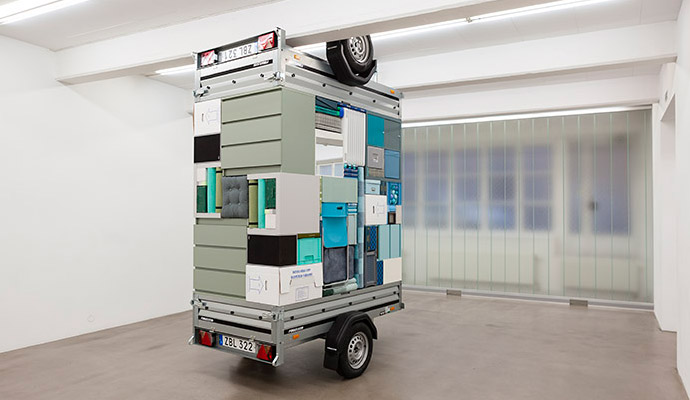
'Never Odd Or Even' (2018), as this work is called, is a palindromic phrase which reads the same way in both directions. Every look at the work confirms its title.
"I am fascinated walking around flea markets finding doubles of seemingly unique, though often useless objects I have already purchased at another flea market. Despite the fact that I did not have any use for them even the first time, the desire to own two of these objects becomes too strong to resist. The unique and unknown origin of the object increases my desire to want the double – the unlikelihood of this sensation repeating itself produces an attraction that is too strong to resist." — Michael Johansson
Born in Trollhättan, Sweden, Michael Johansson studied at the Art Academy in Trondheim, the Kunsthochschule Berlin-Weißensee and the Royal College of Art, Stockholm, before completing his MFA at Malmö Art Academy in 2005. In the tradition of artists such as Tony Cragg, Bill Woodrow and Allison Wilding, who began to envision prefabricated objects as raw materials for sculpture, Johansson abandoned drawing and painting in favour of flea market treasures.
Michael Johansson is best known for his playful, puzzle-like installations consisting of different objects, that study the possibilities and limits of space, and for his numerous public artworks. Johansson's working method is one of collecting, arranging, stacking and puzzling. In his sculptures and installations he gives a new form and context to everyday objects. Most of the things Johansson uses he collects from various flea markets and thrift shops, but some of the objects are items he has carried with him for years. These are things that he for some reason bought a long time ago, without any specific idea of how to use them. He has always been more or less a avid collector, but ever since he started to work with object-based sculptures, he feels kind of a relief that there's a chance that something unnecessary he already owns might fit perfectly into his sculpture, and that he has to let it go. This has really changed his view on things, and he has gotten rid of a lot of the unnecessary items that used to take up space in his apartment. Now they take up space in my studio instead, as possible material for an upcoming work. Lately he has begun to sort things into boxes that are divided by color to become his visual inventory.
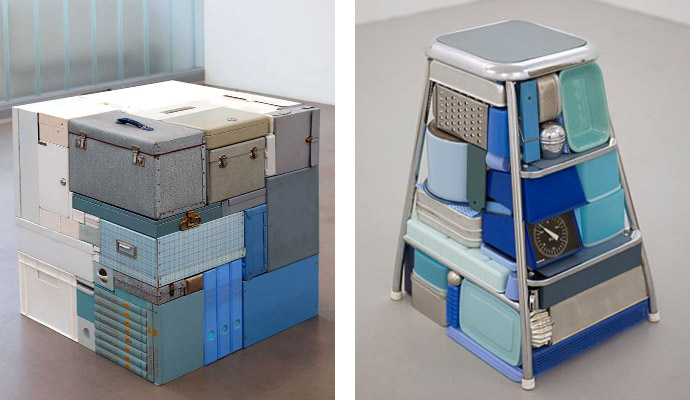
The artist puzzles, stacks and organizes this chaos of everyday objects carefully by color and transforms them into geometric, abstract sculptures. Everyday objects undergo an aesthetic and spacial transformation in Johansson’s hands. Objects tend to be defined and regarded by the context in which they are positioned. As such, a commonplace object can be rendered invaluable or worthless, functional or useless, dependent entirely upon its placement. In the art of Michael Johansson, objects are disassociated from their original purpose and opened up for new readings. By freeing them from their primary function and combining them by the hundreds, he presents us before riddles with a labyrinth of answers. By grouping the items together, Johansson creates an accidental narrative that ties the pieces together in a fantastical story. In the presence of his large-scale interventions, you experience the everyday object in a new light, or perhaps even notice it at all for the very first time.
Johansson’s work appears simultaneously neat and chaotic. Comprised of a variety of discarded, incongruous objects of different size and usage, the assembled collages, are nevertheless orderly, balanced and perfectly geometrical. The random shapes and sizes of everyday objects become marvelously packed forms or installations. These are very often square-sized to create the illusion that the items he uses are morphed together into a new whole. Playing with ideas of ordinary and uniqueness, Johansson makes something extraordinary out of something otherwise ordinary. A monochrome color scheme is another consistent feature of his works, providing well-defined form and visual calm. Deliberate exaggeration is also key, with bathroom scales piled high, suitcases jammed inside each other or a caravan packed out with objects. This reflects Johansson’s obsession with finding doubles of seemingly unique and often useless objects.
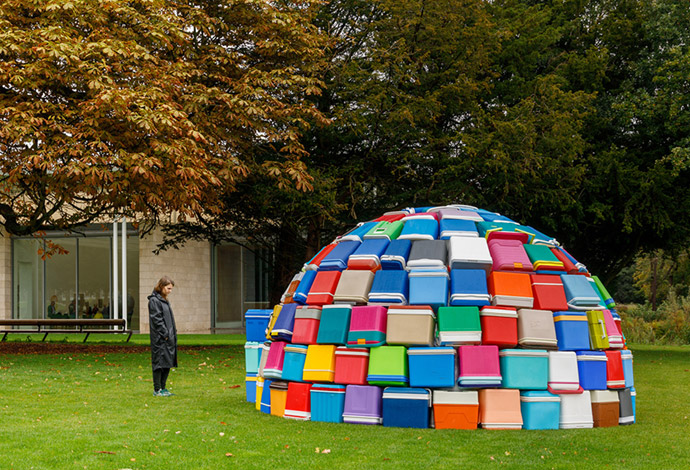
'Sista Sommaren' (Last Summer), 2014 | Collected objects together form a new recognizable object, such as this richly colored igloo of picnic coolers in the garden of Museum Voorlinden in Wassenaar, The Netherlands. On the one hand, the igloo refers to Eskimo houses, on the other hand it is also a reference to a large manufacturer of cool boxes.
Visually confined playfulness also characterizes the art of Michael Johansson. He's obsessed with the investigation of spatial possibilities. Everyday objects are dismantled, re-organized and perfectly arranged into color-coordinated puzzles, filling out select voids of any dimension. Just about any space is an invitation for Johansson’s cleverly executed and gravity-defying aesthetics. Aside from matching in their color, the included objects are often thematically connected as well, addressing a certain human activity or interest.
"Michael Johansson collects histories, as it were. The objects he uses were once purchased and discarded by someone. They already have a life behind them. He gives them a second life. Collecting and arranging the objects appeals to everyone's imagination. We are all trying to bring some order to the world around us." — Suzanne Swarts, Museum Voorlinden
Johansson's work is inspired by coincidences in everyday life, such as the same colors and patterns in objects, two people passing each other dressed in the same outfit a parking space packed by only red cars, or discovering that an actor is playing two different roles at the same time when switching between TV channels. These situations makes him stop in his daily routine and look at things differently. A few years ago he was mainly working with photography, and at that time, he thought the connection to the situations described above were more obvious in the work itself. But even though this inspiration might have become less obvious lately, he thinks it is the same thing compelling him in spotting unexpected situations in daily life, the mix between the common and the unexpected, that is central in all of his works.
Tightly and meticulously packed like some kind of three-dimensional puzzle, the constituent pieces acquire an unexpected coherence that boggles the mind. Therefore, his free standing sculptures and as public installations filling up doorways, arches and even alleyways are often described as "real life Tetris, Tetrism or Compactism". Using Tetris-like moves, he flips each pieces and moves them around until they fit perfectly. No slot goes unfilled. And as every artist is forced into a category, forced to assume a specific identity that clarifies their objective and creative process. For a long time, Johansson was collecting various objects without any idea of what to use them for. In his practice, he was mostly making project-based works including photo and video, but at the end of his Master's education, he regretted not having taken more chances during his studies (this sounds familiar). In some ways, he saw his final presentation as the last chance to take that leap before the harsh reality awaited, and he decided to see where working with the collected objects he had stored would take him. This resulted in his first series of sculptures but also presented him with a challenging framework contributing both possibilities and limitations from which he could create a context of his own. At that time Johansson didn't see any clear references, but of course there are a lot of artists working in similar ways, both today and in the past.
He thinks you have to do your best to come up with your own method of work, and keep doing that; otherwise both him and the viewer will lose interest of his work. Even though his works might seem to have been following the same structure for the last years, his reasons for using certain objects and in what context to put them have continuously changed. Johansson is intriged to hear the different labels put on his work, especially since most of them, like Tetrism or Compactism, are expressions he has never heard of before. But there is also a risk being labeled since this also adds expectations that might limit the possible development of future work.
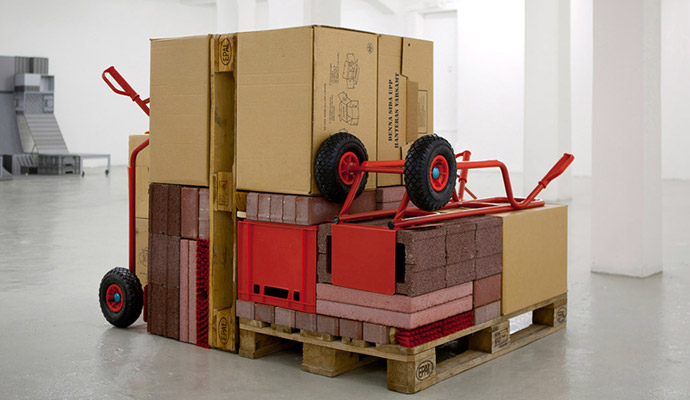
According to Johansson, the use of space in many different ways has a major impact on the result of the work. Space is just as important as the objects themselves. When he started using objects to build a specific environment, he realized quite immediately that in order to create an obsessive atmosphere for this environment, he also had to find a way to create some kind of restrictive framework. "We are so used to having too many things around us in our daily life; just filling a room with a large number of objects was not enough. But when using an already established restriction, regardless of the size of this restriction, every part that takes part in the process also becomes necessary for the fulfillment of the work. The different objects all turn into each other and you cannot remove them without also removing the balance of the work itself", according to Johansson.
Finding a suitable space to fill is usually the first problem to solve when creating a site-specific piece of things found within the same institution or gallery where the work is on display. This is actually the case with most of Johansson's work; the surrounding space usually forms the framework for how the rest of the sculpture will unfold. He sometimes thinks about how similar his method of making a work today is to how his process used to be when making drawings in prep school. Somehow, it feels natural to start with the big picture before focusing on the details.
For Johansson, the process for coming up with a new work starts when a deadline is getting closer, and the context for that specific situation helps to set the parameters for how to proceed. For example, the size and shape of an exhibition’s space or a certain theme for an exhibition might play a role in the outcome of the piece. After that, he usually collects objects for quite some time, until he starts to feel unsure of whether he will be able to finish the work in time. He has tried to change that pattern, but he believes he needs that extra pressure to get started, and maybe this also helps him to stay focused. To put the different objects together is actually the part of the process that takes the least time. But there's always a critical moment when there are too many loose ends at the same time, and Johansson feels that everything is about to collapse. Since there's no beginning and no end of the puzzle, changing or removing one object also has consequences on the other end of the piece, but so far he has always been able to tie the work together eventually. Yep, the dude’s kinda got problems. But man does he know how to makes that look good.
"I am intrigued by irregularities in daily life. Not those that appear when something extraordinary occurs, but those that are created by an exaggerated form of regularity. Colors or patterns from two separate objects or environments concur, like when two people pass each other dressed in the exact same outfit. Or when you are switching channels on your TV and realise that the same actor is playing two different roles on two different channels at the same time. Or that one day the parking lot contained only red cars." — Michael Johansson
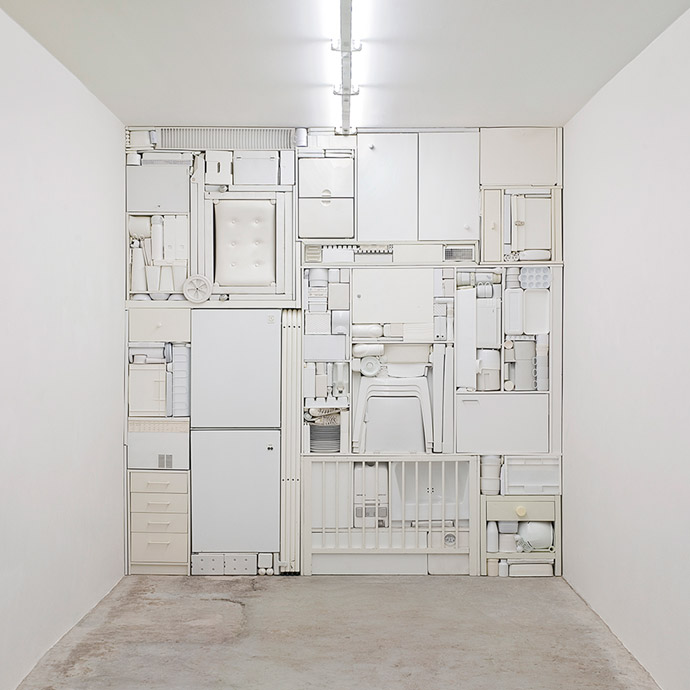
The artistic research of Michael Johansson revolves around an almost obsessive collection and measuring of objects. This process leads the artist to his creations of heterogenous conglomerates whose multivalent significance is meticulously calibrated and always differs. Forms and colors seem to be inextricably entwined, welded together by some disconcerting magnetism. For Johansson, an everyday object like a chair seat represents a metaphor for a familiar space that must be organized and filled at a very junction, interpreting the intrinsic nature of every juxtaposition.
Outdated items within the same color range are reconstructed into a homogeneous image of a fictional life reinforced by our collective imaginary: the compressed scenery from a time gone by. Or the excessively well packed storage space where each object appears to be an immutable part of a solid whole. The newfound rigid order separates the objects from their usage, and invites us to a shared space where the familiar meets the unfamiliar.
Another current in Johansson's work deals with his aim to bring his collected objects a step in the wrong direction in the line of production. Fascinated by assembling objects from model kits as a child, Johansson transforms everyday objects into models of themselves. In series such as Some Assembly Required and Engine Bought Separately, Johansson reverse-engineers objects back into model kits. These life-size kits comment on our relationship with objects, ironically referencing functionality while at the same time eliminating it.
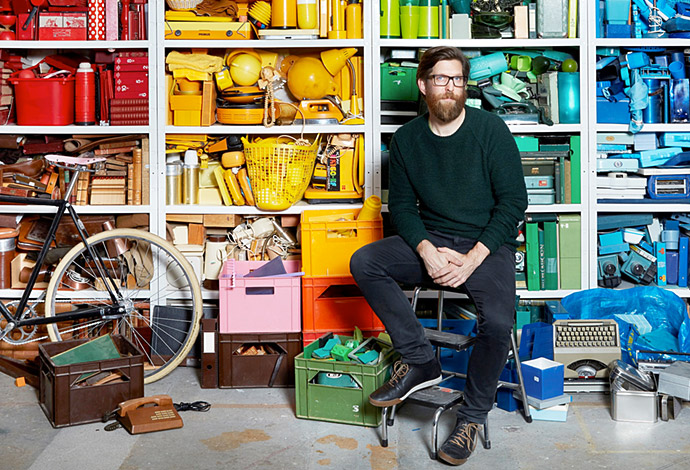
"It is important to me that the objects within each work are connected on several levels, that not only the notions of color and shape adds up, but that the objects also make sense between themselves when it comes to qualities such as origin and spirit of time. But of even greater importance is that the work has the ability to connect with the viewer on several levels." — Michael Johansson
Dealing with our generation’s obsession with 'things' is of course one major aspect of his work. But Johansson is also intrigued by questions about functionality, efficiency, and the thin line between order and chaos, to mention some. He would never bother spending all this time putting his pieces together if he didn't think his work held commentaries on today’s way of living, but he thinks the interpretation of the work can, and must, vary with each person, depending on their very own experiences and view on life.
Although his pieces tend to explore the obsessive nature that drives this generation, many of the objects Johansson uses seem to be obsolete in modern society, as found in Strolls Through Time and Space. Is it an attempt to make a connection between the past and modern day?
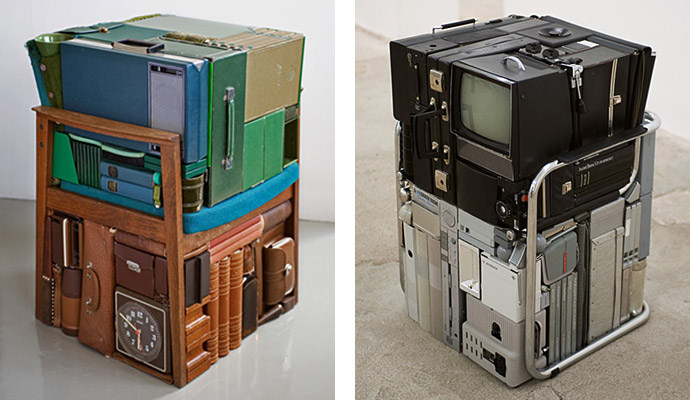
The main reason why Johansson has chosen to mostly work with used and outdated objects is that he's interested in the history they hold. For him, this concentration of objects of different origin, into one imaginary image of a fake reality, is much more intriguing than using newly produced objects purchased at the nearest supermarket. It is something about the knowledge that there are only a limited number of these particular objects left that increases the unlikeliness of them being morphed together with such a precise fit. But in the same way, it feels necessary to deal with topics that are up to date when it comes to the concept. Hoarding and consumerism are probably more current topics today than they have ever been, which of course is something that both the artist and the viewer have in mind in the making and interpretation of the piece. But Johansson also believes the meaning we read into it could change with time, and that the same work could be used to illustrate a different matter in a different context.
If you're looking for someone to come tidy your apartment, I think I have found your man in Michael Johansson, the knack of compartmentalizing the right objects into the right spaces to create incredible collages of no longer used goods in a colorful, eye-popping way.
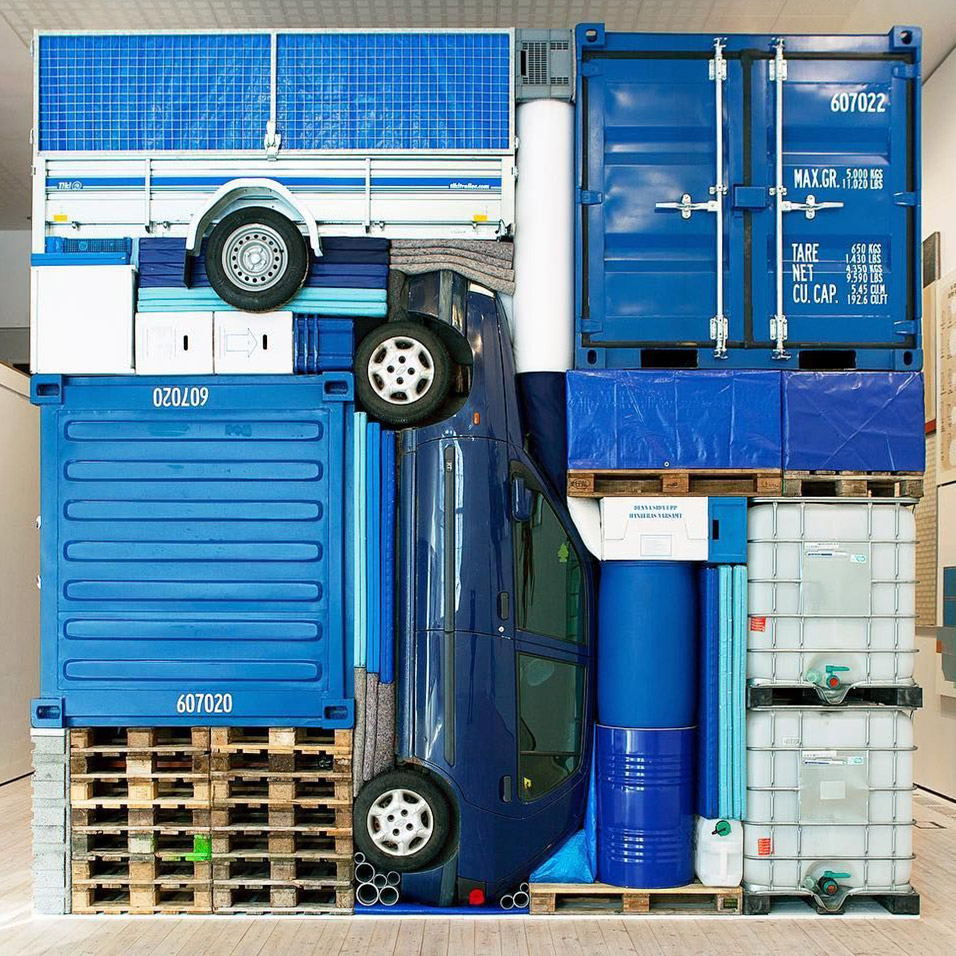
Stay amazed!
All images courtesy of the artist. All images featured © Michael Johansson.
Photo of Michael Johansson in front of the wall with boxes filled with colored objects © Gustaf Waesterberg. The photo of the igloo is the courtesy of Museum Voorlinden.
Related stories on Woodland:
Sources:
